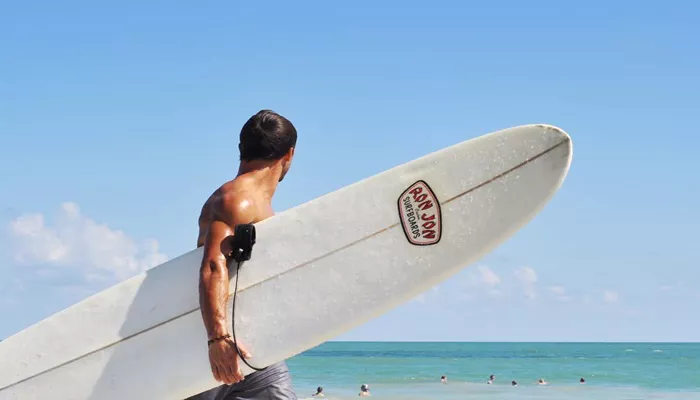Surfing is a physically demanding sport that requires a combination of strength, endurance, flexibility, and balance. Whether you are a beginner preparing for your first surf trip or an experienced surfer looking to enhance performance, proper conditioning is key to improving paddling efficiency, wave-catching ability, and overall surfing endurance.
A well-rounded surf training program includes cardiovascular fitness, strength training, core stability, flexibility, and balance exercises. In this article, we will break down the essential components of surf fitness and provide a structured approach to getting in peak shape for the waves.
Why Surf-Specific Training is Important
Unlike traditional workouts, surf training must replicate the unique demands of surfing:
Paddling endurance to stay out in the lineup longer.
Upper body and core strength to improve paddling and popping up on the board.
Lower body strength for stability and control when riding waves.
Flexibility and mobility to prevent injuries and improve agility.
Balance and coordination to adapt to the dynamic ocean environment.
Cardiovascular Conditioning for Surfing
Paddling is one of the most exhausting aspects of surfing. Developing strong cardiovascular endurance will help you stay in the water longer and recover faster between waves.
1. Swimming Workouts
Swimming mimics paddling and is one of the best cardiovascular exercises for surfers:
Freestyle Laps: Improve shoulder endurance and breath control.
Sprint Intervals: Simulate the explosive paddling needed to catch waves.
Underwater Breath Holds: Increase lung capacity for duck diving and hold-downs.
2. High-Intensity Interval Training (HIIT)
HIIT sessions build stamina and power for short bursts of effort:
Burpees (3 sets of 10-15 reps) – Mimic the pop-up motion.
Rowing Machine (5-minute intervals) – Strengthen shoulders and back for paddling.
Jump Squats (3 sets of 15 reps) – Enhance leg power for turns and maneuvers.
3. Running and Cycling
If swimming isn’t accessible, running or cycling can be effective alternatives:
Trail Running – Develops endurance while improving ankle stability.
Sprint Training – Improves short bursts of explosive energy needed for catching waves.
Strength Training for Surfing Performance
Strength training should focus on functional movements that enhance paddling, pop-ups, and wave riding stability.
1. Upper Body Strength for Paddling Power
Pull-ups (3 sets of 8-12 reps) – Build lat and upper back strength.
Push-ups (3 sets of 15-20 reps) – Strengthen chest and shoulders for paddling.
Dumbbell Shoulder Press (3 sets of 12 reps) – Improve shoulder endurance.
Resistance Band Rows (3 sets of 15 reps) – Develop pulling power for efficient paddling.
2. Core Stability for Balance and Control
Planks (Hold for 45-60 seconds, 3 rounds) – Strengthen deep core muscles.
Russian Twists (3 sets of 15 reps per side) – Improve rotational strength.
Hanging Leg Raises (3 sets of 12 reps) – Enhance lower abdominal endurance.
Medicine Ball Slams (3 sets of 15 reps) – Increase explosive core power.
3. Lower Body Strength for Stability
Squats (3 sets of 12-15 reps) – Develop leg strength for bottom turns and maneuvers.
Lunges (3 sets of 10 reps per leg) – Improve single-leg stability.
Calf Raises (3 sets of 20 reps) – Strengthen ankles for better foot control.
Deadlifts (3 sets of 8 reps) – Build overall power and endurance.
Flexibility and Mobility for Injury Prevention
Surfing requires a full range of motion to execute turns and maneuvers smoothly. Incorporating mobility exercises into your routine will improve performance and reduce injury risk.
1. Yoga for Surfing
Yoga enhances flexibility, balance, and breath control:
Downward Dog: Stretches shoulders, hamstrings, and lower back.
Cobra Pose: Increases spinal mobility for better paddling posture.
Warrior Poses: Strengthen legs and improve stance stability.
Twisting Poses: Enhance rotational flexibility for maneuvers.
2. Dynamic Stretching Before Surfing
Pre-surf warm-ups should include:
Arm Circles – Loosen shoulders for paddling.
Hip Openers – Prepare for quick pop-ups.
Leg Swings – Activate lower body for turns.
3. Post-Surf Recovery Stretches
After surfing, cool down with:
Child’s Pose: Stretches lower back and shoulders.
Hamstring Stretch: Prevents stiffness in the legs.
Chest Opener Stretch: Relieves paddling fatigue.
Balance and Coordination Training
Since surfing is a dynamic sport, improving balance is crucial for stability on the board.
1. Balance Board Training
Balance boards help mimic the instability of a surfboard:
Single-Leg Stands: Improve ankle stability.
Squats on Balance Board: Strengthen legs and core.
Pop-Up Drills: Reinforce proper technique.
2. TRX Suspension Training
TRX workouts enhance core control and coordination:
TRX Lunges: Improve balance and strength.
TRX Plank Holds: Build core endurance.
TRX Rows: Strengthen back for paddling.
Mental Conditioning for Surfing Performance
Surfing isn’t just about physical fitness—it requires mental resilience as well.
1. Breathwork Training
Learning to control your breathing enhances endurance and confidence in heavy surf:
Box Breathing: Inhale for 4 seconds, hold for 4 seconds, exhale for 4 seconds.
Wim Hof Method: Increases lung capacity and oxygen efficiency.
2. Visualization Techniques
Imagining successful rides and pop-ups can enhance muscle memory and confidence.
3. Mindfulness and Stress Management
Practicing mindfulness reduces anxiety and improves focus in challenging conditions.
Surf-Specific Drills to Simulate Ocean Conditions
1. Dry Land Pop-Up Drills
Practice pop-ups on a yoga mat to develop muscle memory.
2. Ocean Simulation Workouts
Perform paddling drills in a pool with a surfboard.
Use resistance bands to mimic paddling resistance.
Conclusion
Getting in shape for surfing requires a blend of cardiovascular endurance, strength training, flexibility, balance work, and mental conditioning. By incorporating these surf-specific exercises into your routine, you’ll enhance paddling power, pop-up speed, and overall surfing performance. Whether you’re preparing for a surf trip or aiming to improve your skills, consistent training will make your time in the water more enjoyable and rewarding.

